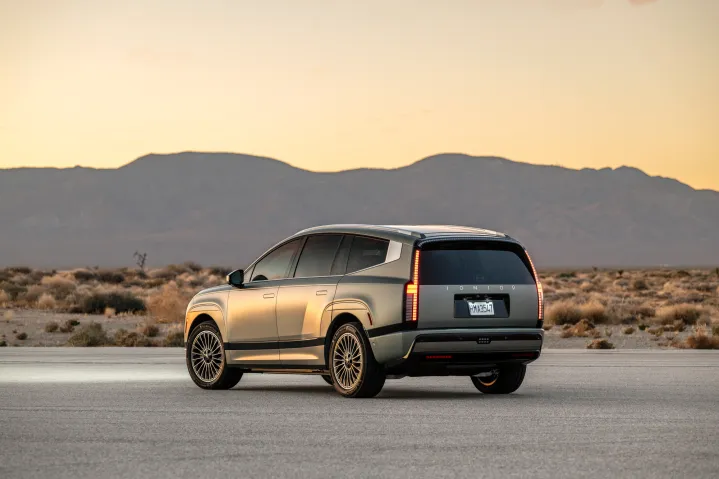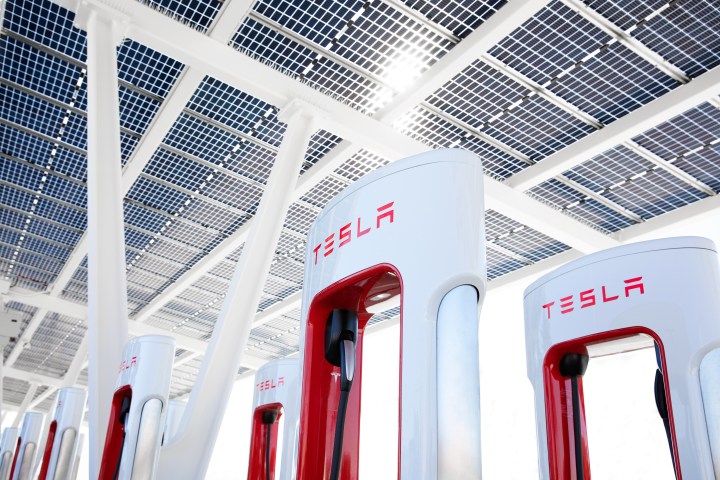The long-awaited Hyundai Ioniq 9 is finally on the way, after months of waiting for what many hope will be a true competitor to the Kia EV9. The electric SUV is likely to be one of the go-to options for those who want a larger EV at a lower price than the likes of the Rivian R1S. But, there’s a refresh to the Model Y, the most popular EV, on the way — in the form of the Tesla Model Y Juniper.
The two vehicles are a bit different when it comes to things like performance, range, and charging. Is the Hyundai Ioniq 9 worth the extra cash, or should you go for the cheaper, yet smaller car? We put the two head-to-head to find out.
Design
The overall designs of the Hyundai Ioniq 9 and Tesla Model Y are pretty different, and that may be enough to sway your buying decision. The Ioniq 9 is a true SUV; it’s big and boxy, and while it looks a little sleeker than some SUVs thanks to its curved roofline, it’s clearly larger than the Tesla Model Y. At the front of the Ioniq 9 is a long light bar separated into pixel-like blocks that helps give the vehicle a unique design motif. At the rear of the Ioniq 9, you’ll also find pixel lights curving around the sides and top of the trunk. The Ioniq 9 measures 199.2 inches long, 78 inches wide, and 70.5 inches high.

While the Tesla Model Y has been out for some time now, it’s getting a bit of a design refresh in the form of the Model Y Juniper. The updated vehicle swaps the more traditional headlights for a light bar that’s split into three parts. It’s coupled with another light bar on the back. To be sure, if you’ve seen a Tesla before, you’ll immediately recognize the Model Y. It still looks a lot like other Teslas, apart from the new Cybertruck.
Ultimately, design is subjective, so we’re not going to award a win here — you’ll have to decide for yourself which vehicle you like the look of more. That said, as you can tell, the Ioniq 9 is a fair bit larger.
Winner: Tie
Interior and tech
The larger build of the Ioniq 9 translates to more space on the inside. The Ioniq 9 has three rows of seating, and we expect the Model Y Juniper will eventually have three rows too, considering the previous-generation model has an option for three rows of seats. Even then, while three rows of seats will come standard on the Ioniq 9, it’ll only ever be an option for the Model Y, if it becomes available at all.

The interior design of the Model Y matches Tesla’s general design aesthetic. It’s minimalistic and sleek, with a largely empty dashboard that’s only interrupted by the larger infotainment display. That display is how you’ll interact with everything about the vehicle — including actual infotainment, tracking speed, gear, and so on. In other words, there’s no instrument monitor behind the steering wheel. Thankfully, Tesla’s software is largely considered to be among the best. For the Model Y Juniper, Tesla has added some additional accent lighting, along with a secondary display for the second-row passengers, to control their own climate zone and other settings.
The Ioniq 9 takes a more conventional approach, offering two front-row displays — one for infotainment and one for instrument monitoring. While Hyundai’s infotainment software isn’t as good as Tesla’s, the Ioniq 9 does support CarPlay and Android Auto, which helps alleviate that a little.

Ultimately, the Ioniq 9 has more room and supports CarPlay, while the Model 3 is more modern and has Tesla’s own better software. Again, you’ll need to decide what’s most important for you.
Winner: Tie
Performance
The overall performance is a little different between these two vehicles. The Tesla Model Y is built to be quick, even despite its lower price, while the Ioniq 9 is built more for comfort than speed.
That doesn’t necessarily mean the Ioniq 9 is slow, but its acceleration isn’t as breakneck as that of some competitors. The Ioniq 9 will be available in three different powertrains at launch. The base model will have one 215-horsepower motor powering the rear wheels. Step up from there and there’s an all-wheel drive model that adds a 94-hp motor on the front wheels. The Performance AWD variant replaces that lower-power front motor with a second 215-hp one. The base model will be able to accelerate from 0-60 miles per hour in 9.4 seconds, however, the Performance AWD variant has an acceleration time of a faster 5.2 seconds.

There are some things we don’t yet know about the performance of the Model Y Juniper though. The rear-wheel drive version of the Model Y Juniper is currently only available in China, and it’s rated as being able to accelerate to 100 km/h in 5.9 seconds. When it launches in the U.S., its acceleration time to 60 mph (96.5 km/h) will likely be slightly lower. The all-wheel drive version of the vehicle being sold in the U.S. right now can get to 60 mph in only 4.1 seconds, which is pretty impressive. There’s no word yet on a Performance variant of the Model Y Juniper.
Safe to say, the Tesla Model Y is a little more impressive than the Ioniq 9 when it comes to performance. It gets the win here.
Winner: Tesla Model Y
Range and charging
The Ioniq 9 has been announced, but it’s not yet available for purchase, and we don’t know the exact range of all models. We do know that Hyundai says that all launch models of the Ioniq 9 will offer at least 300 miles of range, which is a great start. We also know that the Long Range RWD model will have a 335-mile range. On top of a decent range, the Ioniq 9 can also charge quickly. It’s built on an 800-volt architecture, and supports charging speeds of up to 350 kilowatts, which is the fastest charging speed you can get at public chargers right now.

There are also plenty of things we don’t know about the range of the Tesla Model Y Juniper. The RWD Model Y being sold in China has 593 kilometers of range, which equates to 368 miles. The CLTC in China, which assesses EV range, is usually more lenient than the EPA in the U.S. — so those numbers will likely be a little lower when the vehicle comes to North America. That said, the all-wheel drive Model Y Juniper currently available in the U.S. has a range of 320 miles. The Tesla Model Y supports charging speeds of up to 250kW, which isn’t quite as quick as the Ioniq 9.
Given the fact that the vehicles have a similar range, but the Ioniq 9 has a faster charging speed, it gets the win here.
Winner: Hyundai Ioniq 9
Pricing and availability
The Hyundai Ioniq 9 has been announced, but it’s not available just yet. It should become available some time in early 2025. We don’t know exactly how much it’ll cost, but it will likely have a similar price as the Kia EV9, which starts at around $55,000.
The Tesla Model Y has been available for some time now, but the refreshed Model Y Juniper is in the early stages of its rollout. In the U.S., you can currently only get a special-edition version of the vehicle called the Launch Edition New Model Y, which has some special styling, and costs $59,990. If you order it at the time of this writing, you’ll get it in March 2025.
Still, at least we have specific pricing and a date for a version of the Model Y. And, even when they’re both available, the Model Y will likely be cheaper. It’s the winner here.
Winner: Tesla Model Y
Overall winner: Tesla Model Y
These vehicles are pretty different. The Model Y, however, is more powerful and cheaper than the Ioniq 9. That said, you should still consider the Ioniq 9 if you’re looking for a larger vehicle with three rows of seating and support for things like CarPlay.




